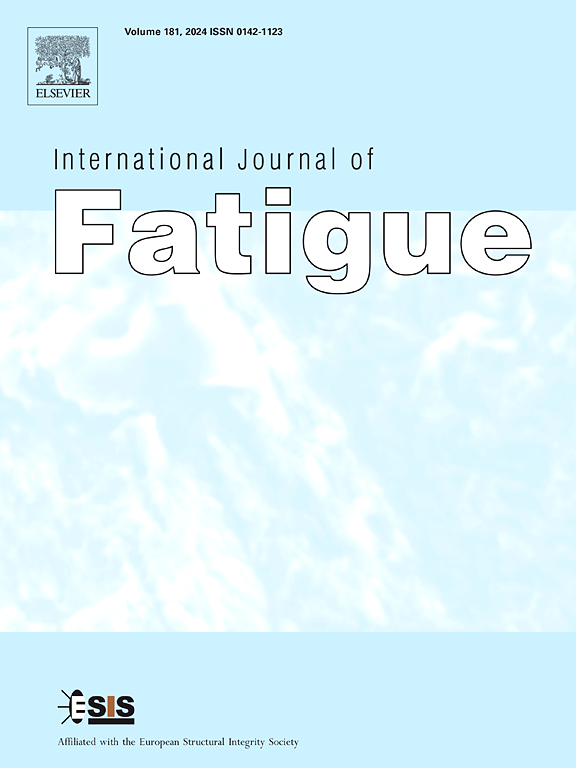不同加载取向、预应变和环境温度下高锰孪晶塑性钢的低周疲劳行为及寿命预测模型
IF 6.8
2区 材料科学
Q1 ENGINEERING, MECHANICAL
引用次数: 0
摘要
在449 K温度下,研究了相对于轧制方向轴向为0°、45°和90°的高锰孪晶诱导塑性(TWIP)钢的低周疲劳行为。考虑预变形(p型)和非预变形(f型)加载条件,总应变幅值范围(Δε/2)为0.6 % ~ 2.4 %。将疲劳行为与我们最近在室温(295 K, Song等)下的工作进行了比较。intj疲劳2023),以获得不同温度下不同变形机制的更全面分析。实验结果表明,温度升高显著提高了材料的塑性,同时降低了材料的强度。在高温(449 K)下施加严重的塑性预应变会显著降低疲劳寿命,这与室温下的行为明显不同。这些特性都与加载方向和应变幅值有关。本文章由计算机程序翻译,如有差异,请以英文原文为准。
Low-cycle fatigue behavior and life-prediction model of high-manganese twinning-induced plasticity steels with different loading orientations, pre-strains, and ambient temperatures
The low-cycle fatigue behavior of high-manganese twinning-induced plasticity (TWIP) steel is examined for specimen axial orientations of 0°, 45°, and 90° relative to the rolling direction at a temperature of 449 K. The study aims at a total strain amplitude range (Δε/2) of 0.6 % to 2.4 %, considering both pre-deformed (P-type) and non-pre-deformed (F-type) loading conditions. The fatigue behavior is compared to our recent work at room temperature (295 K, Song et al. Int J Fatigue 2023), to obtain a more comprehensive analysis of the varying deformation mechanisms with different temperatures. Experimental results show that elevated temperature significantly increases the ductility of the material while reducing its strength. Applying a severe plastic pre-strain at high temperature (449 K) will dramatically decrease fatigue life, which is markedly different from the behavior at room temperature. All these characteristics are related to the loading orientations and strain amplitudes.
Additionally, a life-prediction model for high-Mn steel that considers different deformation mechanisms at varying temperatures is also proposed. The model demonstrates fatigue life predictions across 77 loading cases, encompassing five orientations, seven strain amplitudes, three types of loading modes, and two temperatures. The comparison of experimentally and analytically determined lives shows the comprehensive descriptive capacity of the proposed model.
求助全文
通过发布文献求助,成功后即可免费获取论文全文。
去求助
来源期刊

International Journal of Fatigue
工程技术-材料科学:综合
CiteScore
10.70
自引率
21.70%
发文量
619
审稿时长
58 days
期刊介绍:
Typical subjects discussed in International Journal of Fatigue address:
Novel fatigue testing and characterization methods (new kinds of fatigue tests, critical evaluation of existing methods, in situ measurement of fatigue degradation, non-contact field measurements)
Multiaxial fatigue and complex loading effects of materials and structures, exploring state-of-the-art concepts in degradation under cyclic loading
Fatigue in the very high cycle regime, including failure mode transitions from surface to subsurface, effects of surface treatment, processing, and loading conditions
Modeling (including degradation processes and related driving forces, multiscale/multi-resolution methods, computational hierarchical and concurrent methods for coupled component and material responses, novel methods for notch root analysis, fracture mechanics, damage mechanics, crack growth kinetics, life prediction and durability, and prediction of stochastic fatigue behavior reflecting microstructure and service conditions)
Models for early stages of fatigue crack formation and growth that explicitly consider microstructure and relevant materials science aspects
Understanding the influence or manufacturing and processing route on fatigue degradation, and embedding this understanding in more predictive schemes for mitigation and design against fatigue
Prognosis and damage state awareness (including sensors, monitoring, methodology, interactive control, accelerated methods, data interpretation)
Applications of technologies associated with fatigue and their implications for structural integrity and reliability. This includes issues related to design, operation and maintenance, i.e., life cycle engineering
Smart materials and structures that can sense and mitigate fatigue degradation
Fatigue of devices and structures at small scales, including effects of process route and surfaces/interfaces.
 求助内容:
求助内容: 应助结果提醒方式:
应助结果提醒方式:


